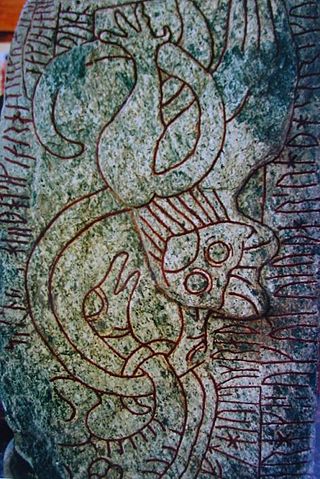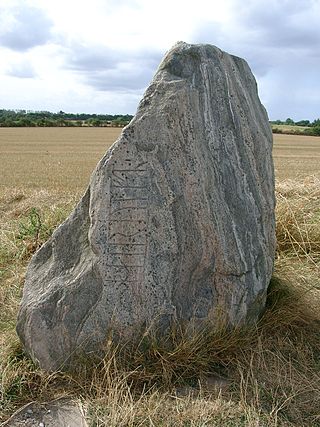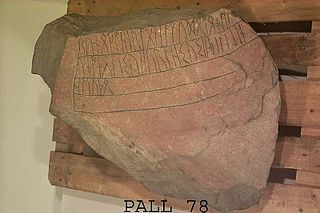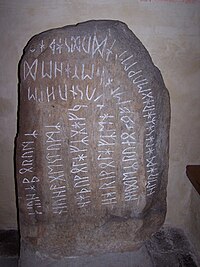
A rune is a letter in a set of related alphabets known as runic alphabets native to the Germanic peoples. Runes were used to write Germanic languages before they adopted the Latin alphabet, and for specialised purposes thereafter. In addition to representing a sound value, runes can be used to represent the concepts after which they are named (ideographs). Scholars refer to instances of the latter as Begriffsrunen. The Scandinavian variants are also known as fuþark, or futhark, these names derived from the first six letters of the script, ⟨ᚠ⟩, ⟨ᚢ⟩, ⟨ᚦ⟩, ⟨ᚨ⟩/⟨ᚬ⟩, ⟨ᚱ⟩, and ⟨ᚲ⟩/⟨ᚴ⟩, corresponding to the Latin letters ⟨f⟩, ⟨u⟩, ⟨þ⟩/⟨th⟩, ⟨a⟩, ⟨r⟩, and ⟨k⟩. The Anglo-Saxon variant is futhorc, or fuþorc, due to changes in Old English of the sounds represented by the fourth letter, ⟨ᚨ⟩/⟨ᚩ⟩.
The Younger Futhark, also called Scandinavian runes, is a runic alphabet and a reduced form of the Elder Futhark, with only 16 characters, in use from about the 9th century, after a "transitional period" during the 7th and 8th centuries. The reduction, somewhat paradoxically, happened at the same time as phonetic changes that led to a greater number of different phonemes in the spoken language, when Proto-Norse evolved into Old Norse. Also, the writing custom avoided carving the same rune consecutively for the same sound, so the spoken distinction between long and short vowels was lost in writing. Thus, the language included distinct sounds and minimal pairs that were written the same.

The Elder Futhark, also known as the Older Futhark, Old Futhark, or Germanic Futhark, is the oldest form of the runic alphabets. It was a writing system used by Germanic peoples for Northwest Germanic dialects in the Migration Period. Inscriptions are found on artifacts including jewelry, amulets, plateware, tools, and weapons, as well as runestones in Scandinavia, from the 2nd to the 10th centuries.

Proto-Norse or Proto-North Germanic was an Indo-European language spoken in Scandinavia that is thought to have evolved as a northern dialect of Proto-Germanic in the first centuries CE. It is the earliest stage of a characteristically North Germanic language, and the language attested in the oldest Scandinavian Elder Futhark inscriptions, spoken from around the 2nd to the 8th centuries CE. It evolved into the dialects of Old Norse at the beginning of the Viking Age around 800 CE, which later themselves evolved into the modern North Germanic languages.

The Björketorp Runestone in Blekinge, Sweden, is part of a grave field which includes menhirs, both solitary and forming stone circles.
The Scandinavian Runic-text Data Base is a project involving the creation and maintenance of a database of transliterated runic inscriptions. The project's goal is to comprehensively catalog runestones in a machine-readable way for future research. The database is freely available via the Internet with a client program, called Rundata, for Microsoft Windows. For other operating systems, text files are provided or a web browser can be used to interact with the web application Runor.
A runic inscription is an inscription made in one of the various runic alphabets. They generally contained practical information or memorials instead of magic or mythic stories. The body of runic inscriptions falls into the three categories of Elder Futhark, Anglo-Frisian Futhorc and Younger Futhark.

The Snoldelev Stone, listed as DR 248 in the Rundata catalog, is a 9th-century runestone that was originally located at Snoldelev, Ramsø, Denmark.

The sequence alu is found in numerous Elder Futhark runic inscriptions of Germanic Iron Age Scandinavia between the 3rd and the 8th century. The word usually appears either alone or as part of an apparent formula. The symbols represent the runes Ansuz, Laguz, and Uruz. The origin and meaning of the word are matters of dispute, though a general agreement exists among scholars that the word represents an instance of historical runic magic or is a metaphor for it. It is the most common of the early runic charm words.
The Blekinge stones are four early Elder Futhark runestones found in Blekinge, Sweden:

The Sparlösa Runestone, listed as Vg 119 in the Rundata catalog, is located in Västergötland and is the second most famous Swedish runestone after the Rök runestone.

The Hærulf Runestone is a Viking Age runestone located north of Hovslund's station in Southern Jutland, Denmark.

The Gummarp Runestone, designated as DR 358, was a runestone from the Vendel era and which was located in the former village of Gummarp in the province of Blekinge, Sweden.

The Istaby Runestone, listed in the Rundata catalog as DR 359, is a runestone with an inscription in Proto-Norse which was raised in Istaby, Blekinge, Sweden, during the Vendel era.

The Rö runestone, designated under Rundata as Bo KJ73 U, is one of Sweden's oldest and most notable runestones.
The Järsberg Runestone is a runestone in the elder futhark near Kristinehamn in Värmland, Sweden.

The Noleby Runestone, which is also known as the Fyrunga Runestone or Vg 63 for its Rundata catalog listing, is a runestone in Proto-Norse which is engraved with the Elder Futhark. It was discovered in 1894 at the farm of Stora Noleby in Västergötland, Sweden.

The Manx runestones were made by the Norse population on the Isle of Man during the Viking Age, mostly in the 10th century. Despite its small size, the Isle of Man stands out with many Viking Age runestones, in 1983 numbering as many as 26 surviving stones, which can be compared to 33 in all of Norway. So many of them may appear on the Isle of Man because of the merging of the immigrant Norse runestone tradition with the local Celtic tradition of raising high crosses.

The Bjälbo runestones are three Viking Age memorial runestones, one of which has been lost, located at Bjälbo, which is a village in Mjölby Municipality, Östergötland, Sweden. One of the inscriptions provides evidence of the existence of guilds in Sweden during this period.














